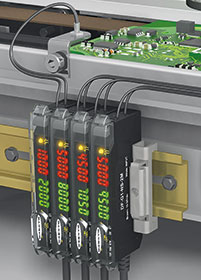

Fibre optics is used to transmit light energy over long distances. Optical fibres are thin, transparent strands of optical quality glass or plastic that can be as thin as a strand of hair. In photoelectric sensing, these fibres are used to transmit or receive light from the LED of a sensor.
The fibre consists of a glass or plastic core surrounded by a layer of cladding material and, for plastic fibres, jacketing. Glass fibres are arranged in bundles, and plastic fibres are usually packaged as monofilaments. Glass fibres do not have jacketing. Instead, the bundles are packaged in sheathing that is usually stainless steel flexible conduit, but may be PVC or some other type of flexible plastic tubing. A protective steel coil can also be used beneath the sheath to protect the fibre bundle.
Types of fibres
Glass fibre optics
Glass fibre optics is made up of a bundle of very small (usually about 50 micron diameter) glass fibre strands. A typical assembly consists
of several hundred fibres, protected by a sheathing material, usually a flexible armoured cable, which are mostly used in challenging environments, such as applications with high temperature, corrosive substances, or moisture.
Plastic fibre optics
Plastic fibre optics usually have a larger, monofilament core. It is not always bundled, and comes in a single strand of material typically 0,25 to 1,5 mm in diameter. Plastic fibres are typically used for more general purpose applications where they can tolerate extreme bending and be cut to length to fit in setups where space is limited.
How a fibre optic system works
How optical fibres transport light rays can be explained using the principle of total internal reflection. This states that any ray of light
hitting the boundary between the core and the cladding (which have different densities) will be totally reflected, provided that the angle of incidence is less than a certain critical value. The light beam is transported all the way through the tiny fibre by reflection, exiting at the same approximate angle as it entered the fibre.
There is, however, a tendency for the signal to degrade over distance. Attenuation of the signal will occur, depending on the purity of the core material.
Fibre optic assemblies
A fibre optic assembly determines the sensing mode. Therefore, the type of fibre that is chosen determines the assembly required by the application.
Individual fibre optic assemblies
Individual fibre optic assemblies simply guide light from an emitter to a sensing location or from the sensing location back to a receiver. The configuration determines the sensing mode and individual assemblies are usually used in pairs for opposed-mode applications.
Bifurcated fibre optic assemblies
Bifurcated optics conducts the emitted light together with the received light via two branches, consisting of different fibres, within one fibre optic assembly. This allows a single sensor to both illuminate and view an object through the same optic assembly.
If an object appears in front of the sensing end of a bifurcated assembly, light from one branch will be reflected off the object and back to the receiver through the other branch. Bifurcated assemblies are typically used in diffuse mode sensing and can also be used in retro-reflective sensing applications.
Typical applications for fibre optics
Because of the inherent attributes, fibre optics are ideal in the following applications:
• Vibratory feeders
• Conveyors
• Pill counting
• Small object detection
• Ovens
• Robotic arms and moving machines
For more information contact Brandon Topham, RET Automation, +27 11 453 2468, [email protected], www.retautomation.com
| Tel: | +27 11 453 2468 |
| Email: | [email protected] |
| www: | www.turckbanner.co.za |
| Articles: | More information and articles about Turck Banner Southern Africa |

© Technews Publishing (Pty) Ltd | All Rights Reserved